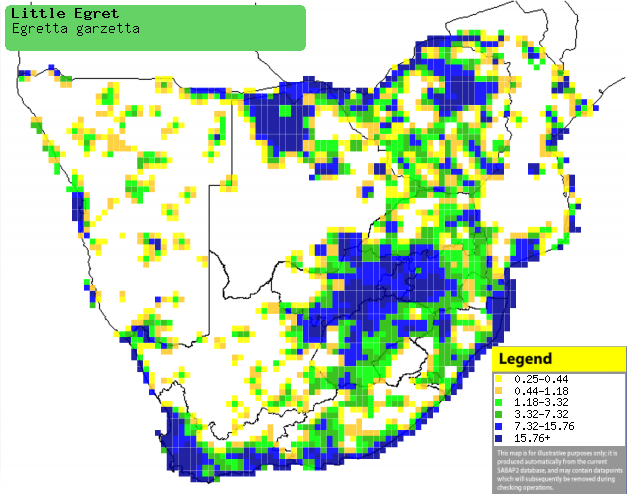|
Egretta garzetta (Little egret)
Kleinwitreier [Afrikaans]; iNgekle (also applied to Yellow-billed egret)
[Zulu]; Samunkoma (also applied to other long-neck egrets and herons)
[Kwangali]; Leholosiane (generic term for egret) [South Sotho]; Kleine
zilverreiger [Dutch]; Aigrette garzette [French]; Seidenreiher [German];
Garça-branca-pequena [Portuguese]
Life
> Eukaryotes >
Opisthokonta
> Metazoa (animals) >
Bilateria >
Deuterostomia > Chordata >
Craniata > Vertebrata (vertebrates) > Gnathostomata (jawed
vertebrates) > Teleostomi (teleost fish) > Osteichthyes (bony fish) > Class:
Sarcopterygii (lobe-finned
fish) > Stegocephalia (terrestrial
vertebrates) > Tetrapoda
(four-legged vertebrates) > Reptiliomorpha > Amniota >
Reptilia (reptiles) >
Romeriida > Diapsida > Archosauromorpha > Archosauria >
Dinosauria
(dinosaurs) > Saurischia > Theropoda (bipedal predatory dinosaurs) >
Coelurosauria > Maniraptora > Aves
(birds) > Order: Ciconiiformes
> Family: Ardeidae
Distribution and habitat
Occupies much of sub-Saharan Africa, largely excluding the
equatorial lowland forest of the DRC and west Africa. In southern Africa, it is uncommon to
locally common in central and southern Mozambique, Zimbabwe, northern and
eastern Botswana, patches of Namibia and much of South Africa, largely excluding
the arid Northern Cape. It generally prefers the shallow margins of rivers,
lakes, estuaries, pans, marshes and saltpans, but it also moves into mangroves,
open coastal flats and man-made habitats such as sewage works, canals and
dams.
|
 |
|
Distribution of Little egret in southern Africa,
based on statistical smoothing of the records from first SA Bird Atlas
Project (©
Animal Demography unit, University of
Cape Town; smoothing by Birgit Erni and Francesca Little). Colours range
from dark blue (most common) through to yellow (least common).
See here for the latest distribution
from the SABAP2. |
Predators and parasites
- Parasites
- Sarcocystis
- Theromyzon cooperi (African duck leech)
- botulism
Movements and migrations
Generally resident in perennial water bodies,
but it may make nomadic movements in search of ephemeral wetlands.
Food
It mainly eats fish, doing most of its foraging by wading
or running through the water, stabbing at prey. It also uses a technique in
which it hovers above the
water surface then dives down to catch its prey. Foraging techniques sometimes exploit the movements of
other animals, such as Hippopotamus (Hippopotamus amphibius),
cormorants or
African spoonbills, as it
catches the prey they disturb. The following food items have been recorded
in its diet:
- Vertebrates
- fish
- amphibians
- reptiles
- small birds
- small mammals
- Invertebrates
- crustaceans
- insects
- worms
- crustaceans
- molluscs
Breeding
- Monogamous colonial nester, breeding in groups of roughly 2-120 nests,
interspersed with those of other water birds in a large, mixed-species
colony.
- The nest is built by the female with material provided by the male,
consisting of a platform of sticks and reeds, typically placed in a tree or
bush above water or a reedbed, although it is rarely positioned on cliffs or rocks.
- Egg-laying season is from August-March.
- It lays 2-4 eggs, which are incubated by both sexes for roughly 21-25
days.
- The chicks are brooded and fed by both parents, leaving the nest at
approximately a month old and fledging 10-20 days later.
Threats
Not threatened.
References
-
Hockey PAR, Dean WRJ and Ryan PG 2005. Roberts
- Birds of southern Africa, VIIth ed. The Trustees of the John Voelcker
Bird Book Fund, Cape Town.
|
